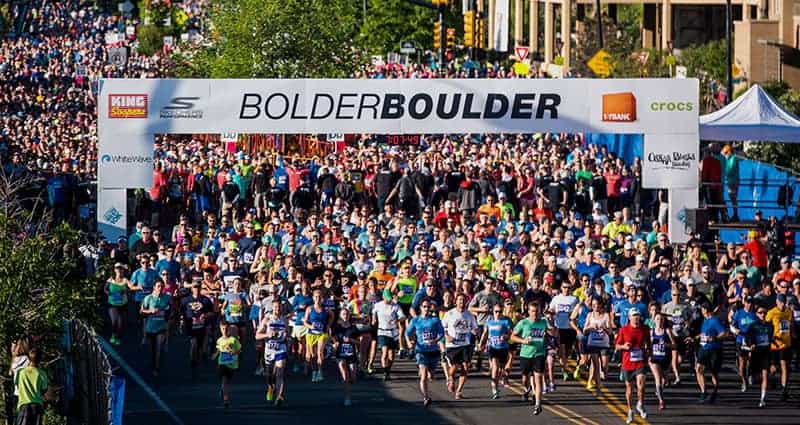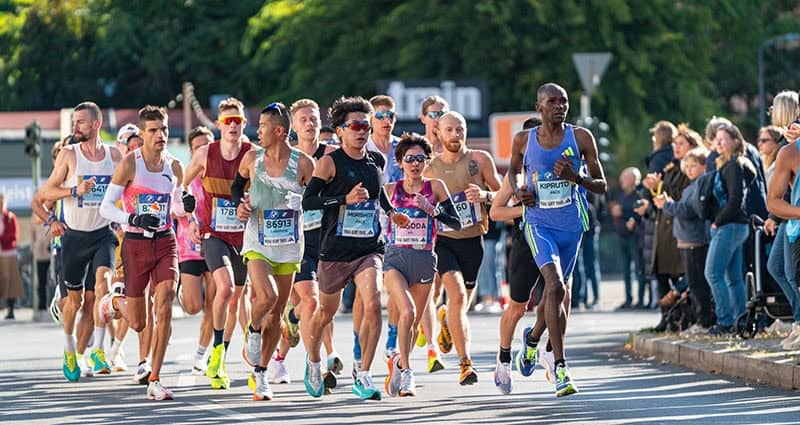Do you want to run a faster 10K? Look no further than this article.
The 10K sits between two popular road race distances: the 5K and the half marathon—but not quite in the middle. The 10K is only 5 km longer than a 5K race but 10 km shorter than a half marathon. Hence, the physiological demands of the 10K are much closer to those of its shorter cousin.
And yet, the 10K places significant demands on both speed and endurance. Marathoners often retreat to 10K training to work on their speed—while still employing a significant long run—and 5K runners benefit from more endurance without sacrificing much of their speed. And then there are dedicated 10K runners, of course.
Whatever your motive, having a fast 10K result to your name earns bragging rights in the running community.
What is a Good 10K Time?
A 10K is not the ultimate test of endurance, but if you don’t have a sports background, just finishing one is an achievement. For seasoned runners, sub-40 minutes are considered good; for Olympians, it must be well under 30 minutes.
What is the 10K World Record?
The 10K world records are held by Uganda’s Joshua Cheptegai, in 26:11 minutes, and Ethiopia’s Letesenbet Gidey, in 29:01 minutes for women. Notable masters world records are Juan Antonio Cuadrillero’s 30:04 at age 50 and Ed Witlock’s 42:58 at age 80. In the women’s division, Lindo Somers ran the 10K in 34:14 at age 50 and Deidre Larkin in 54:17 at age 80.
While recalling those exact times may be of minor importance, they should inspire anyone to imagine what’s possible.
What is the Average 10K Time?
The average time to complete a 10K race is approximately 48 minutes for men and 54 minutes for women, regardless of age. However, it is more insightful to categorize by training level under the age of 50. The following categories—admittedly somewhat arbitrary—provide a good reference point:
Men
- Beginner: above 50:00
- Intermediate: 50:00 – 40:00
- Advanced: below 40:00
Women
- Beginner: above 56:00
- Intermediate: 56:00 – 45:00
- Advanced: below 45:00
What is Your 10K Potential?
If you are among the lucky 2 percent with world-class potential, you should be able to run the 10K in 32 minutes with 25 miles (40 km) per week. On the other hand, if your genetic potential is average (50th percentile), but you build up your training to high mileage like a semi-professional athlete, you’ll come into striking distance of a low-mileage, highly talented runner.
That should be encouraging. For a 100m sprinter, inherent ability matters much more than it does in distance running.
10K Training Zones
As mentioned, a fast 10K time requires speed and endurance. If your training favors one over the other, your first line of attack should be removing your weakness. For example, if you lack endurance, prioritize your tempo and long runs for the next training cycle. If you lack speed, focus more on VO2 max intervals and anaerobic power.
And if you have neither strengths, nor weaknesses, increase your training volume.
Endurance
The 10K may not be a long race, but if your long runs are limited to 7 or 8 miles, you won’t come anywhere close to your potential. Regular long runs of 12 miles and beyond take your 10K to another level. It also helps to include long progression runs into your buildup, with the final miles run at moderate or marathon pace.
Lactate Threshold
The 10K is raced slightly above your lactate threshold. That means running at a pace where lactate is produced faster than it can be cleared. In other words, you’re accumulating lactate. With appropriate training, you can push your lactate turnpoint upward, which lets you access a higher percentage of your VO2 max.
VO2 max
Maximal aerobic capacity is a great predictor of 10K race performance. VO2 max is typically trained between 10K and 3K race pace, or 90 – 100 percent of VO2 max, respectively. 10K pace is also terrific to improve the lactate threshold; therefore, you kill two birds with one stone during these intervals.
Speed
You may not need the speed of a miler to succeed over the 10K, but you want to ensure you have a large enough speed reserve so that a lack of power isn’t a hindrance to your VO2 max interval training. That doesn’t mean you need to grit out 400s at 1500m pace, but you do need to make use of fast surges and hill sprints.
10K Training Phases
Repeating the same training weeks over and over will only get you so far. That’s why elite runners periodize their training with training cycles that build on each other until a peak is reached. Then rinse and repeat.
Here’s a sound periodization cycle from general to 10K race-specific intensities:
Base Training
The 6-week base phase is relatively simple: building up easy mileage, increasing the long run, and adding a few hill sprints to some easy runs. That’s it. The sole purpose of the base phase is to develop a large aerobic foundation and the strength that supports the training in the following phases.
If your base is limited, everything you do that follows will have a limited effect.
- Easy runs
- Moderate runs
- Long runs
- Hill sprints
Support Training
The support phase is also 6 weeks long. During this period, VO2 max and the aerobic threshold are developed. The first workout of the week includes intervals/repetitions at 5K to 1500m pace. The second workout, 72 hours apart, involves a tempo run at high-end aerobic paces slightly under your lactate threshold, such as HM and marathon pace.
- Easy runs
- Long runs
- Marathon pace
- HM pace
- 5K pace
- 3K pace
- 1500m pace
- Hill sprints
Race-Specific Training
The race-specific phase is 4 weeks long, including the race taper. During the 2 key workouts, lactate threshold (15K pace) serves as direct endurance support and 5K pace as direct speed support. 10K goal pace training is also emphasized to peak in time for your upcoming 10K race. Hill sprints are discontinued and replaced by flat sprints.
- Easy runs
- Long runs
- 15K pace
- 10K pace
- 5K pace
- flat sprints
10K Workouts
The following list describes common running workouts modified for a 10K race preparation.
Easy Runs
Easy runs are any training plan’s bread and butter runs. Although easy runs have a wide intensity range, many runners make the mistake of running easy run either too hard or too slow. I recommend monitoring your heart rate in addition to pace and keeping the intensity between 60 – 70% of your heart rate reserve. You can calculate this with the Karvonen Formula.
- 40 – 70 min @ easy pace
Long Runs
You don’t need monster long runs to run a faster 10K. But if you think going a little over race distance cuts it, you’re mistaken. This may work if you are a beginner—where any training is leapfrogging you forward—but not if you’re a seasoned runner. Aim for 12 – 13 miles, even if only on alternating weeks. Advanced runners can also make use of long progression runs.
Here’s a sample of how to increase your long run:
- 75 min @ easy
- 90 min @ easy
- 105 min @ easy
- 45 min easy + 45 min moderate
- 90 min moderate
- 75 min moderate + 15 min marathon pace
Tempo Runs
Tempo runs are excellent to advance the endurance side for the 10K. Start with longer steady-state tempo runs at marathon pace and then gradually move toward lactate threshold pace over several weeks.
The following transition is an example for advanced runners:
- 40 min @ marathon pace
- 35 min @ 30K pace
- 30 min @ HM pace
- 5x 5 min @ 15K pace w/ 90 sec easy
- 3x 10 min @ 15K pace w/ 2 min easy
- 25 min @ 15K pace
VO2 max Intervals
The intensity range for VO2 max intervals is 3K to 10K pace. That means for a 10K race preparation, you can beautifully progress your VO2 max training from shorter intervals at 3K pace to race-specific intervals at 10K pace. By the time you arrive at the longer 10K paced intervals you will also have the endurance backup of your lactate threshold sessions from the other key workout.
Take the following example as a guidpost for your VO2 max progression and adapt it to your level:
- 8x 400m @ 3K pace w/ 2 min jog
- 6x 600m @ 3K pace w/ 2:30 min jog
- 6x 800m @ 5K pace w/ 2:30 min jog
- 5x 1000m @ 5K pace w/ 3 min jogs
- 4x 1600m @ 10K pace w/ 400m easy
- 4x 2000m @ 10K pace w/ 400m easy
Speed Repetitions
Unlike for the 5K, you don’t need to run anaerobic 400m repeats. But there’s still merit in 200m repeats imparted in Fartlek runs early in your training cycle. This make the transition to VO2 max training easier since your muscles are used to handle faster efforts. Also include some hill sprints throughout the training cycle.
- 8x 150m @ 1500m pace
- 8x 200m @ 1500m pace
- 12x 200m @ 1500m pace
General speed work throughout the training cycle at the end of easy runs:
- 4 – 8x 10 sec hill sprints all-out (6 – 10 % grade)
- 4 – 8x 10 sec relaxed sprints @ 400m race pace
10K Race Strategy
With all the training in the bank, it’s time to prove yourself. Here’s what I recommend before, during, and after your race.
10K Race Taper
The 10K—like any race—benefits from a race taper. But it doesn’t have to be a 2 or even 3-week-long taper as it’s common for the marathon. You’re not recovering from 20-milers, after all. Keep up your usual training volume until about a week from race day, and convert the long run before race week into an easy run. During race week you should run at 10K goal pace in your 2 key workouts but with shorter intervals so that it doesn’t overly tax your body before race day.
10K Warm Up
For my coached athletes and in my 10K training plans it starts with a short shakeout run the day before the race. That can be as short as a mile for a beginner or up to 3 miles for an advanced runner. Include 2 or 3 strides at 1500m pace at the end of it. This ensures you won’t feel flat on race day. Don’t overdo it if you’re above 40, as it taxes your nervous system. On race day, follow through with a warm-up routine similar to your interval workouts. That means 5 – 10 minutes of easy running, followed by dynamic stretching and a few drills. After that, run a few more minutes at a moderate pace and speed up to 5K pace with a few surges no longer than 100m.
10K Pacing Strategy
The fastest pace is an even pace. While it’s tempting to give in to the adrenaline rush at the start of the race and elbow yourself into a good position early, I can guarantee you that you will likely become prey during the remainder of the race rather than a hunter. When you take a loan from your anaerobic energy system, you must pay it back with interest later in the race. Instead, stay at your goal pace from the beginning. Done right, the first 3 miles feel comfortably hard, miles 3 to 5 somewhat of a mental challenge, and the final mile is quite manageable again with the goal in sight.
Post-10K Recovery
I recommend you do a short cool-down run a few minutes after the race. I know it’s tempting to celebrate right away after a race, but if you can spare 5 minutes for a cool-down, you’ll feel better the next day. Other than that, enjoy mingling with the other finishers and take advantage of the various sports drinks and snacks your race organizer and his sponsors provide. I recommend to forego any hard workouts for 6 days after the race. But if you want to run a faster 10K again in 2 or 3 weeks—as you perhaps should—then resume regular training after 4 days. However, there will come a point when you’ve maxed out your current training cycle, and it’s time to start all over again with an even bigger goal in mind.
Summary
- Be realistic, but set your standards high
- Build a large aerobic foundation
- Enhance your lactate threshold
- Improve your VO2 max
- Add some speed work
- Have a solid pacing strategy




